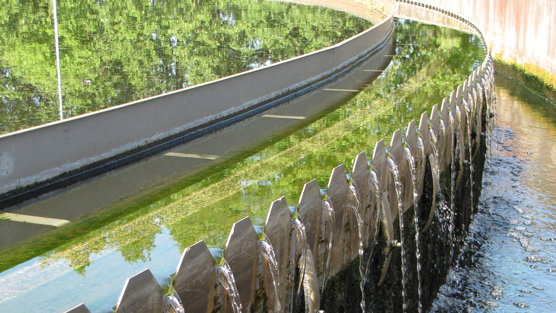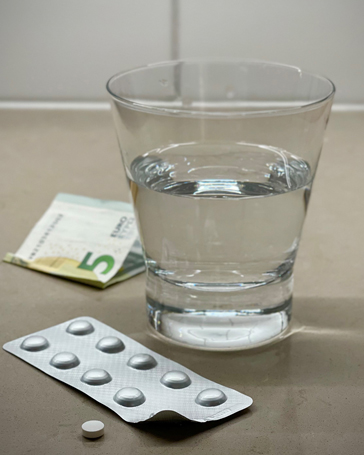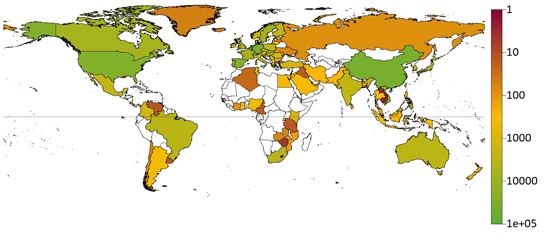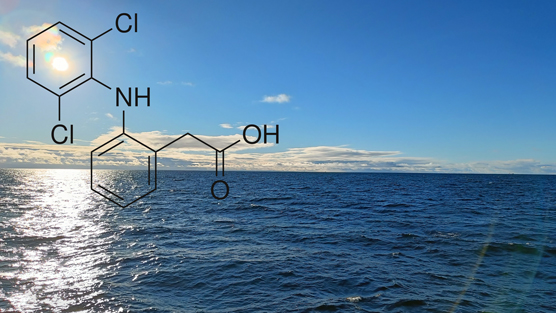Upgrading of Swedish wastewater treatment plants – research and practice hand in hand
Author: Michael Cimbritz, Department of Chemical Engineering, Lund University, michael.cimbritz(at)chemeng.lth.se
The Swedish Environmental Protection Agency is distributing grants until 2023 for measures that improve the water environment in seas, lakes and waterways. Municipalities have been given the opportunity to apply for funds for pre-studies and investments in advanced wastewater treatments to remove pharmaceuticals and other organic micropollutants. This has led to the upgrading of several full-scale facilities in Sweden. Behind the expansions lies extensive research and development work, for example within the framework of a project coordinated by Lund University and financed by Interreg South Baltic.

Sweden aims to further improve water quality by studying and implementing advanced wastewater technologies. © Photo: Lauri Äystö
A national organization for increased knowledge
The contributions of the Environmental Protection Agency should not only lead to concrete measures in the form of full-scale installations, but also contribute to increased knowledge build-up by highlighting issues related to the planning, projecting, procurement, installation and operation of full-scale plants. Therefore, a client/tender group has been formed to promote knowledge exchange between different stakeholders. The overall goal is the cost-effective introduction of efficient and reliable technical solutions, and the group is managed by the Swedish Water and Wastewater Association. Information is disseminated primarily through an annual seminar and through various reports posted on the client group's website.
New facilities and new research
At the time of writing, there are several full-scale plants in operation in Sweden, based on either ozone or granulated activated carbon or both. Some of the facilities are located in Skåne (in Simrishamn, Kivik, S:t Olof and Degeberga). Others are found in Ronneby, Linköping and Tierp and more facilities are in the planning stage. The development can be followed via the client group's website.
There are also several ongoing pilot projects in collaboration between municipalities, universities and research institutes. In Skåne, successful research has been conducted within the framework of the LESS IS MORE project financed by Interreg South Baltic and with members from Sweden (Department of Chemical Engineering at Lund University, Sweden Water Research and Kristianstad University), Lithuania (Kretinga Water), Denmark (Slagelse Utility and Slagelse Municipality) and Poland (Gdansk Water Fund). The project provided opportunities not only for the demonstration of full-scale activated carbon filtration but also for the development of new and exciting methodology for studies of removal mechanisms in various processes for the removal of organic micropollutants.
Radioactive pharmaceuticals to develop future treatment processes
By radioactively labelling different substances we (at the Department of Chemical Engineering at Lund University) have developed a new approach to study interactions in for example ozonation and activated carbon adsorption.
During ozonation, pharmaceuticals and other substances are converted into various transformation products. We know that toxicity is usually lower following ozonation, but there are thousands of substances to keep track of and it is almost impossible to map all reaction pathways and new transformation products. However, with radioactive labelling of wisely selected substances, we can follow important groups of substances through an ozonation process or through a carbon filter.
This means that we for example can investigate whether formed transformation products can be biologically degraded or whether they can be fixed to activated carbon in post-treatment. Such knowledge is a central piece in the design of future processes for the removal of organic micropollutants.
Further reading:
-
Betsholtz, A., Juárez, R., Svahn, O., Davidsson, Å., Cimbritz, M., Falås, P., 2022. Ozonation of 14C-labeled micropollutants – mineralization of labeled moieties and adsorption of transformation products to activated carbon. Water Res. 221.
Finns are willing to pay for a more environmentally friendly pharmaceutical sector
Author: Lasse Alajärvi, University of Eastern Finland, lasse.alajarvi(at)uef.fi
A recent study by the School of Pharmacy at the University of Eastern Finland demonstrates preferences for a more environmentally friendly pharmaceutical sector among Finnish residents. The study shows Finns’ valuations for different aspects of an environmentally friendly pharmaceutical policy and the effect of environmental attitudes on Finns’ valuations.
Although the environmental impact of medicines is a well-known threat to biodiversity, and the users of medicines are the major source of pharmaceuticals in the environment (PiE), the valuations and preferences among the population for the environmental friendliness of the pharmaceutical sector are a rarely studied topic. The valuations of Finnish residents for the environmental friendliness of the pharmaceutical sector were studied by using a discrete choice experiment as a part of a PiE-themed population survey. In the survey, respondents were presented pharmaceutical policy options aimed at reducing the environmental impact of medicines. The policy options consisted of different combinations of attributes: available information on the environmental impacts of medicines, the geographical scope of the policy, time to the implementation of the changes, the concrete environmental impact of the policy, and the annual cost per person. By using the attribute “annual cost per person”, it was possible to measure the respondents’ perceived utility by money and define the willingness to pay (WTP) for the policy.

Willingness to pay depended significantly on the general environmental attitude of the respondent. Respondents’ household gross income had no effect on their willingness to pay. © Lasse Alajärvi
The respondents considered the concrete environmental impact of the measures, i.e., the reduction in the amount of harmful pharmaceuticals ending up in the environment, as the most important factor of the hypothetical pharmaceutical policy. The second most important factor for the respondents was EU-level policy measures over policy measures covering only Finland or Nordic countries. Access to information on the environmental effects of medicines was ranked as the third most important among the respondents. When generalized to the whole Finnish adult population of 4.5 million residents, the respondents' annual WTP varied from EUR 37 million to EUR 134 million, depending on the policy options. In addition, the willingness to pay depended significantly on the respondent's general environmental attitude. Respondents’ household gross income had no effect on the WTP.
Of the respondents, 39.6% belonged to the most environmentally friendly group, whose willingness to pay was on average over 6 times higher than that of the least environmentally friendly respondents. The least environmentally friendly group included 28.7% of respondents. The most environmentally friendly group included more frequently women, the highly educated, and people over 60 years of age compared to the least environmentally friendly group.
Monetarizing people’s preferences and valuations for a more environmentally friendly pharmaceutical sector helps to assess the population’s perceived value for improvements of environmental friendliness in the pharmaceutical sector. The study results also indicate that improving the general environmental attitudes of the public, for example through education, will also benefit the implementation of environmentally friendly policies in the context of pharmaceuticals.
The survey was conducted as an electronic survey by a Finnish marketing research company Taloustutkimus Oy in December 2019. A total of 2,030 persons 18 to 79 years of age, living in mainland Finland responded to the survey. The study contributes to a multidisciplinary SUDDEN research consortium that aims at reducing the environmental impact of pharmaceuticals and supporting sustainable growth in the pharmaceutical industry. The project is funded by the Strategic Research Council at the Academy of Finland.
Link to the original research article:
Now available: updated UBA database – “Pharmaceuticals in the environment”
Author: Arne Hein, Section Pharmaceuticals, German Environment Agency, arne.hein(at)uba.de
Pharmaceutical residues occur globally in the environment. This is demonstrated in the updated database Pharmaceuticals in the environment (PHARMS-UBA) from the German Environment Agency (UBA). The publicly available database contains over 270,000 data entries from over 2,000 publications.
Background
Over the past decades, human consumption of pharmaceuticals has steadily increased. It is known that their growing use is leading to detectable levels in all environmental compartments, potentially causing harm to ecosystems. However, a concise and comprehensive overview of the relevant pharmaceuticals, their concentrations in the environment and their potential effects on human health and ecosystems is still pending. To organize the huge amount of available information resulting from the global environmental exposure situation, UBA initiated this database project to collect all these data in a single publicly available database.
The present update includes data collected from publicly available literature published until the end of 2020.
Results
The database contains now 276,895 data entries from 2,062 publications. In total, 992 different active substances and/or their transformation products were measured worldwide in concentrations above the detection limits of the respective analytical methods employed, revealing regional patterns. Most of these substances were found in the effluents of wastewater treatment plants (liquid emission – globally: 771, EU: 591). In surface water, groundwater and drinking water, 703 substances were detected globally and 483 in the EU (liquid emmission).
The measured environmental concentrations (MEC) of human and veterinary pharmaceutical residues were reported worldwide for 61 environmental matrices. The matrices with the most MECs are surface water, groundwater, tap/drinking water, sewage, effluents and sludge of wastewater treatment plants (WWTP), soil, sediments and suspended particulate matter.
The database
The data were transferred from the publications, reports, and other data sources into the MEC database. The database is available for download as a Microsoft Excel© or as Microsoft Access© file. Each database entry comprises 33 fields, including amongst others the name of the pharmaceutical substance, its CAS number, the environmental matrix the substance was measured in, geographical location, sampling period, number of measurements, measured concentration in original and standardised units, detection limit of the analytical method employed, pollution source (if available), literature citation, publication language and type, and quality flag.
All references used are compiled in an Endnote© literature database. For transparency and to allow for better working with the MEC database, please download the literature database as a travelling library and in other formats as a zip-file.

Countries with a high number of MECs are shown in green and countries with a low number of MEC data in red. The highest amounts of database entries are from China (37,708 entries), Germany (34,001 entries), Spain (26,988 entries) and the US (25,647 entries). © Source: German Environment Agency / TUD GmbH
HELCOM indicator on diclofenac
Author: Lauri Äystö, Finnish Environment Institute, lauri.aysto(at)syke.fi
HELCOM indicators are used in assessing the status of the Baltic Sea. The second HELCOM holistic assessment included 12 core indicators on hazardous substances. Diclofenac is the first pharmaceutical with a HELCOM indicator under development.

Diclofenac is the first pharmaceutical with a HELCOM indicator under development. © Lauri Äystö
HELCOM indicators
The core indicators included in the second HELCOM holistic assessment (HOLAS2, HELCOM 2018a) included heavy metals (As, Cd, Hg, Pb), radioactive substances (Cs-137), legacy pollutants (PCBs, PCDD/Fs, PAHs), brominated flame retardants (HBCDD and PBDE), and PFOS. While there are no pharmaceuticals included in the HELCOM core indicators, a pre-core test indicator for diclofenac was published in 2018 (HELCOM 2018b). The indicator proposed utilizing environmental quality standards (EQS) derived for the EU Water Framework directive (2000/60/EC) as threshold values. These EQSs are currently under development. Thus, the threshold values for diclofenac have not yet been agreed to commonly in HELCOM, and the indicator has not yet been fully integrated within HELCOM’s holistic assessments.
Threshold values proposed for diclofenac
The threshold values proposed in the 2018 test indicator (HELCOM 2018b) were 5 ng/l for marine waters and 1 µg/kg w.w. for biota. On the other hand, recently the European Commission (EC 2021) proposed EQSs of 4 ng/l for the annual average concentration in marine water and 1.16 µg/kg w.w. for biota. While the proposed EQS values have been criticized e.g. by Leverett et al. (2021), the preliminary opinion of the Scientific Committee on Health, Environmental and Emerging Risks (SCHEER 2022) supported the EQS values for marine water and biota, as proposed by EC 2021.
Indicator development for HOLAS 3
The indicators will be utilized in the third HELCOM holistic assessment (HOLAS 3), which is to be published in 2023. To produce an up-to-date assessment of the status of the Baltic Sea, the indicators are currently being updated.
Assessing the status of the Baltic Sea related to hazardous substances requires concentration data. In May 2021, HELCOM issued an ad-hoc data call for indicators with no existing reporting routines, such as diclofenac. The data was to cover the years from 2016 through to 2021, and to be reported by the end of May 2022. The data call covered not only surface waters and biota, directly related for the 2018 test-indicator, but also all relevant data on wastewater treatment plants, rivers, and sediments.
The ad hoc data call resulted in a dataset covering altogether circa 3,600 individual measurements. Datapoints on surface waters accounted for over 70% of the data, out of which less than 15% were marine waters.
The EQS values proposed for diclofenac by EC 2021 are proposed to be utilised as HELCOM threshold values in this pre-core indicator for HOLAS 3. To assess the status of the Baltic Sea related to diclofenac, the reported concentrations were aggregated to HELCOM level 4 assessment units and compared to the proposed threshold values.
In the provisional evaluation carried out for marine areas, the reported data shows nine assessment units to achieve good status (i.e. concentrations do not exceed the proposed threshold values). On the other hand, 15 units fail to achieve good status, and the status is uncertain for 24 units. The status was considered uncertain whenever diclofenac was not detected, but the analytical limit exceeded the proposed threshold value.
Next steps
The work and its results are currently part of an ongoing process. The indicator results were submitted to HELCOM contact points in each country for review until 30th September 2022. After the review, the indicator report is to be finalized in October 2022 and final outcomes are expected in March 2023.
Links to references
-
European Commission (EC) (2021) Draft EQS Datasheet: Diclofenac.
-
HELCOM 2018a. State of the Baltic Sea – Second HELCOM holistic assessment 2011–2016. Baltic Sea Environment Proceedings 155.
-
HELCOM 2018b. Diclofenac. HELCOM pre-core indicator report. July 2018.
-
Leverett, D., Merrington, G., Crane, M., Ryan, J., Wilson, I., 2021. Environmental quality standards for diclofenac derived under the European Water Framework Directive: 1. Aquatic organisms. Environ. Sci. Eur. 33.
-
SCHEER (Scientific Committee on Health, Environmental and Emerging Risks) 2022. Preliminary Opinion on Draft Environmental Quality Standards for Priority Substances under the Water Framework Directive - diclofenac, 6 May 2022.
Do you have something you would like to share to the BSR PHARMA?
Tips on contents for future newsletters are welcomed at BalticPharma(at)syke.fi.